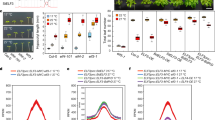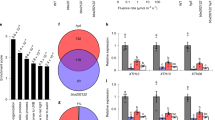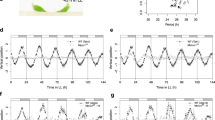Abstract
The circadian clock is required for adaptive responses to daily and seasonal changes in environmental conditions1,2,3. Light and the circadian clock interact to consolidate the phase of hypocotyl cell elongation to peak at dawn under diurnal cycles in Arabidopsis thaliana4,5,6,7. Here we identify a protein complex (called the evening complex)—composed of the proteins encoded by EARLY FLOWERING 3 (ELF3), ELF4 and the transcription-factor-encoding gene LUX ARRHYTHMO (LUX; also known as PHYTOCLOCK 1)—that directly regulates plant growth8,9,10,11,12. ELF3 is both necessary and sufficient to form a complex between ELF4 and LUX, and the complex is diurnally regulated, peaking at dusk. ELF3, ELF4 and LUX are required for the proper expression of the growth-promoting transcription factors encoded by PHYTOCHROME INTERACTING FACTOR 4 (PIF4) and PIF5 (also known as PHYTOCHROME INTERACTING FACTOR 3-LIKE 6) under diurnal conditions4,6,13. LUX targets the complex to the promoters of PIF4 and PIF5 in vivo. Mutations in PIF4 and/or PIF5 are epistatic to the loss of the ELF4–ELF3–LUX complex, suggesting that regulation of PIF4 and PIF5 is a crucial function of the complex. Therefore, the evening complex underlies the molecular basis for circadian gating of hypocotyl growth in the early evening.
This is a preview of subscription content, access via your institution
Access options
Subscribe to this journal
Receive 51 print issues and online access
$199.00 per year
only $3.90 per issue
Buy this article
- Purchase on Springer Link
- Instant access to full article PDF
Prices may be subject to local taxes which are calculated during checkout




Similar content being viewed by others
References
Wijnen, H. & Young, M. W. Interplay of circadian clocks and metabolic rhythms. Annu. Rev. Genet. 40, 409–448 (2006)
Yakir, E., Hilman, D., Harir, Y. & Green, R. M. Regulation of output from the plant circadian clock. FEBS J. 274, 335–345 (2007)
Harmer, S. L. The circadian system in higher plants. Annu. Rev. Plant Biol. 60, 357–377 (2009)
Nozue, K. et al. Rhythmic growth explained by coincidence between internal and external cues. Nature 448, 358–361 (2007)
Michael, T. P. et al. A morning-specific phytohormone gene expression program underlying rhythmic plant growth. PLoS Biol. 6, e225 (2008)
Niwa, Y., Yamashino, T. & Mizuno, T. The circadian clock regulates the photoperiodic response of hypocotyl elongation through a coincidence mechanism in Arabidopsis thaliana . Plant Cell Physiol. 50, 838–854 (2009)
de Montaigu, A., Tóth, R. & Coupland, G. Plant development goes like clockwork. Trends Genet. 26, 296–306 (2010)
Zagotta, M. T. et al. The Arabidopsis ELF3 gene regulates vegetative photomorphogenesis and the photoperiodic induction of flowering. Plant J. 10, 691–702 (1996)
Hicks, K. A., Albertson, T. M. & Wagner, D. R. EARLY FLOWERING3 encodes a novel protein that regulates circadian clock function and flowering in Arabidopsis . Plant Cell 13, 1281–1292 (2001)
Doyle, M. R. et al. The ELF4 gene controls circadian rhythms and flowering time in Arabidopsis thaliana . Nature 419, 74–77 (2002)
Hazen, S. P. et al. LUX ARRHYTHMO encodes a Myb domain protein essential for circadian rhythms. Proc. Natl Acad. Sci. USA 102, 10387–10392 (2005)
Onai, K. & Ishiura, M. PHYTOCLOCK 1 encoding a novel GARP protein essential for the Arabidopsis circadian clock. Genes Cells 10, 963–972 (2005)
Lorrain, S., Allen, T., Duek, P. D., Whitelam, G. C. & Fankhauser, C. Phytochrome-mediated inhibition of shade avoidance involves degradation of growth-promoting bHLH transcription factors. Plant J. 53, 312–323 (2008)
Hicks, K. A. et al. Conditional circadian dysfunction of the Arabidopsis early-flowering 3 mutant. Science 274, 790–792 (1996)
Liu, X. L., Covington, M. F., Fankhauser, C., Chory, J. & Wagner, D. R. ELF3 encodes a circadian clock-regulated nuclear protein that functions in an Arabidopsis PHYB signal transduction pathway. Plant Cell 13, 1293–1304 (2001)
Khanna, R., Kikis, E. A. & Quail, P. H. EARLY FLOWERING 4 functions in phytochrome B-regulated seedling de-etiolation. Plant Physiol. 133, 1530–1538 (2003)
Thines, B. & Harmon, F. G. Ambient temperature response establishes ELF3 as a required component of the core Arabidopsis circadian clock. Proc. Natl Acad. Sci. USA 107, 3257–3262 (2010)
Mockler, T. C. et al. The DIURNAL project: DIURNAL and circadian expression profiling, model-based pattern matching and promoter analysis. Cold Spring Harb. Symp. Quant. Biol. 72, 353–363 (2007)
Michael, T. P. et al. Network discovery pipeline elucidates conserved time-of-day-specific cis-regulatory modules. PLoS Genet. 4, e14 (2008)
Helfer, A. et al. LUX ARRHYTHMO encodes a nighttime repressor of circadian gene expression in the Arabidopsis core clock. Curr. Biol. 21, 126–133 (2011)
Hazen, S. P. et al. Rapid array mapping of circadian clock and developmental mutations in Arabidopsis . Plant Physiol. 138, 990–997 (2005)
Yu, J. W. et al. COP1 and ELF3 control circadian function and photoperiodic flowering by regulating GI stability. Mol. Cell 32, 617–630 (2008)
de Lucas, M. et al. A molecular framework for light and gibberellin control of cell elongation. Nature 451, 480–484 (2008)
Dixon, L. E. et al. Temporal repression of core circadian genes is mediated through EARLY FLOWERING 3 in Arabidopsis . Curr. Biol. 21, 120–125 (2011)
Schwab, R., Ossowski, S., Riester, M., Warthmann, N. & Weigel, D. Highly specific gene silencing by artificial microRNAs in Arabidopsis . Plant Cell 18, 1121–1133 (2006)
Ossowski, S., Schwab, R. & Weigel, D. Gene silencing in plants using artificial microRNAs and other small RNAs. Plant J. 53, 674–690 (2008)
Lu, S. X., Knowles, S. M., Andronis, C., Ong, M. S. & Tobin, E. M. CIRCADIAN CLOCK ASSOCIATED1 and LATE ELONGATED HYPOCOTYL function synergistically in the circadian clock of Arabidopsis . Plant Physiol. 150, 834–843 (2009)
Kikis, E. A., Khanna, R. & Quail, P. H. ELF4 is a phytochrome-regulated component of a negative-feedback loop involving the central oscillator components CCA1 and LHY. Plant J. 44, 300–313 (2005)
Sawa, M., Nusinow, D. A., Kay, S. A. & Imaizumi, T. FKF1 and GIGANTEA complex formation is required for day-length measurement in Arabidopsis . Science 318, 261–265 (2007)
Para, A. et al. PRR3 is a vascular regulator of TOC1 stability in the Arabidopsis circadian clock. Plant Cell 19, 3462–3473 (2007)
Millar, A. J., Carre, I. A., Strayer, C. A., Chua, N. H. & Kay, S. A. Circadian clock mutants in Arabidopsis identified by luciferase imaging. Science 267, 1161–1163 (1995)
Neff, M. M., Turk, E. & Kalishman, M. Web-based primer design for single nucleotide polymorphism analysis. Trends Genet. 18, 613–615 (2002)
Alabadi, D. et al. Reciprocal regulation between TOC1 and LHY/CCA1 within the Arabidopsis circadian clock. Science 293, 880–883 (2001)
Liu, Y. G., Mitsukawa, N., Oosumi, T. & Whittier, R. F. Efficient isolation and mapping of Arabidopsis thaliana T-DNA insert junctions by thermal asymmetric interlaced PCR. Plant J. 8, 457–463 (1995)
Karimi, M., Inzé, D. & Depicker, A. GATEWAY vectors for Agrobacterium-mediated plant transformation. Trends Plant Sci. 7, 193–195 (2002)
Pruneda-Paz, J., Breton, G., Para, A. & Kay, S. A. A functional genomics approach reveals CHE as a component of the Arabidopsis circadian clock. Science 323, 1481–1485 (2009)
Clough, S. J. & Bent, A. F. Floral dip: a simplified method for Agrobacterium-mediated transformation of Arabidopsis thaliana . Plant J. 16, 735–743 (1998)
Plautz, J. D. et al. Quantitative analysis of Drosophila period gene transcription in living animals. J. Biol. Rhythms 12, 204–217 (1997)
Harlow, E. & Lane, D. Using Antibodies: A Laboratory Manual (Cold Spring Harbor Laboratories Press, 1999)
Earley, K. W. et al. Gateway-compatible vectors for plant functional genomics and proteomics. Plant J. 45, 616–629 (2006)
Haring, M. et al. Chromatin immunoprecipitation: optimization, quantitative analysis and data normalization. Plant Methods 3, 11 (2007)
Rozen, S. & Skaletsky, H. Primer3 on the WWW for general users and for biologist programmers. Methods Mol. Biol. 132, 365–386 (2000)
Czechowski, T., Bari, R. P., Stitt, M., Scheible, W. R. & Udvardi, M. K. Real-time RT–PCR profiling of over 1400 Arabidopsis transcription factors: unprecedented sensitivity reveals novel root- and shoot-specific genes. Plant J. 38, 366–379 (2004)
Acknowledgements
P. Y. Pongsawakul illustrated the model in Fig. 4c. We thank G. Breton, T. Hirota, J. Pruneda-Paz, D. Nagel, E. Kolmos and B. J. Cole for critical reading of the manuscript. We also thank J. Halverson, A. L. Quiroz and C. Valdivia for excellent technical assistance. pif4-101 pif5-1 seedlings were a generous gift from S. Lorrain and C. Fankhauser. F. Harmon originally identified the nature of the elf4-3 mutation and designed the dCAPS strategy. This work was supported by a University of California, San Diego, Chancellor’s Undergraduate Research Scholarship (to J.J.K.), grants from the European Molecular Biology Organization (ALTF 236-2005 to A.H.), the National Science Foundation (IBN-0416762 to T.F.S.) and the National Institutes of Health (NRSA GM083585 to D.A.N., NRSA GM080930 to E.E.H., R01 GM79712 to T.I., and R01 GM50006 and GM67837 to S.A.K.).
Author information
Authors and Affiliations
Contributions
D.A.N., A.H., E.E.H., T.I., T.F.S., E.M.F. and S.A.K. designed the experiments. D.A.N. performed and analysed all of the immunoprecipitations and ChIP assays, generated and characterized the anti-ELF3 antibody and the transgenic lines, and generated the plasmids for yeast three-hybrid analysis. D.A.N. also co-performed the gene expression analysis with A.H. A.H. performed the yeast two- and one-hybrid assays and generated and characterized the LUX and LUX/NOX ami transgenic lines. E.E.H. generated the anti-LUX antibody, characterized transgenic lines and co-performed western blot analysis with D.A.N. J.J.K. measured hypocotyls, performed and analysed the yeast three-hybrid assay, and assisted with the yeast one-hybrid analysis and generation of the elf3-2 pif4-101 pif5-1 seedlings. T.I. performed the original yeast two-hybrid assays. T.F.S. generated the ELF4::ELF4–HA elf4-2 line. E.M.F. characterized the ELF4-transgenic lines. D.A.N. and S.A.K. wrote the manuscript.
Corresponding author
Ethics declarations
Competing interests
The authors declare no competing financial interests.
Supplementary information
Supplementary Information
The file contains Supplementary Table 1 and Supplementary Figures 1-12 with legends. (PDF 2011 kb)
Rights and permissions
About this article
Cite this article
Nusinow, D., Helfer, A., Hamilton, E. et al. The ELF4–ELF3–LUX complex links the circadian clock to diurnal control of hypocotyl growth. Nature 475, 398–402 (2011). https://doi.org/10.1038/nature10182
Received:
Accepted:
Published:
Issue Date:
DOI: https://doi.org/10.1038/nature10182
This article is cited by
-
Unlocking allelic variation in circadian clock genes to develop environmentally robust and productive crops
Planta (2024)
-
Acclimation of circadian rhythms in woodland strawberries (Fragaria vesca L.) to Arctic and mid-latitude photoperiods
BMC Plant Biology (2023)
-
Transcriptome profiling at the transition to the reproductive stage uncovers stage and tissue-specific genes in wheat
BMC Plant Biology (2023)
-
Identification of the global diurnal rhythmic transcripts, transcription factors and time-of-day specific cis elements in Chenopodium quinoa
BMC Plant Biology (2023)
-
Limited water stress modulates expression of circadian clock genes in Brachypodium distachyon roots
Scientific Reports (2023)
Comments
By submitting a comment you agree to abide by our Terms and Community Guidelines. If you find something abusive or that does not comply with our terms or guidelines please flag it as inappropriate.



